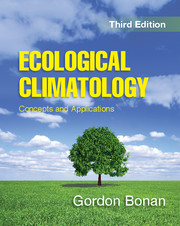Book contents
- Frontmatter
- Dedication
- Contents
- Preface
- 1 Ecosystems and Climate
- Part I The Earth System
- Part II Global Physical Climatology
- Part III Hydrometeorology
- Part IV Biometeorology
- Part V Terrestrial Plant Ecology
- Part VI Terrestrial Forcings and Feedbacks
- 25 Terrestrial Ecosystems and Earth System Models
- 26 Seasonal-to-Interannual Variability
- 27 Biogeophysical Climate–Vegetation Dynamics
- 28 Anthropogenic Land Use and Land-Cover Change
- 29 Carbon Cycle–Climate Feedbacks
- 30 Nitrogen, Chemistry, and Climate
- 31 Aerosols, Chemistry, and Climate
- 32 Urbanization
- 33 Climate Intervention and Geoengineering
- 34 Coevolution of Climate and Life
- Appendix
- Index
- Plate section
- References
32 - Urbanization
from Part VI - Terrestrial Forcings and Feedbacks
Published online by Cambridge University Press: 05 November 2015
- Frontmatter
- Dedication
- Contents
- Preface
- 1 Ecosystems and Climate
- Part I The Earth System
- Part II Global Physical Climatology
- Part III Hydrometeorology
- Part IV Biometeorology
- Part V Terrestrial Plant Ecology
- Part VI Terrestrial Forcings and Feedbacks
- 25 Terrestrial Ecosystems and Earth System Models
- 26 Seasonal-to-Interannual Variability
- 27 Biogeophysical Climate–Vegetation Dynamics
- 28 Anthropogenic Land Use and Land-Cover Change
- 29 Carbon Cycle–Climate Feedbacks
- 30 Nitrogen, Chemistry, and Climate
- 31 Aerosols, Chemistry, and Climate
- 32 Urbanization
- 33 Climate Intervention and Geoengineering
- 34 Coevolution of Climate and Life
- Appendix
- Index
- Plate section
- References
Summary
Chapter Summary
Urban land uses represent an alteration of the natural landscape. The vast tracts of impervious roads, sidewalks, driveways, parking lots, roofs, and walls alter the surface energy budget and the hydrologic cycle. The most prominent characteristic of the urban climate is the urban heat island, by which air temperature in cities can be several degrees warmer than that of rural landscapes. The heat island arises due to reduced emission of longwave radiation by the city surface, much of which is trapped by tall buildings; the low surface albedo of cities; reduced latent heat flux and increased sensible heat flux because of greater impervious surface area; storage of heat in urban materials during the day that is released at night; and from anthropogenic heat sources within the city. Cities also generate more runoff compared with rural landscapes because of greater impervious surface area. Vegetated parks within cities ameliorate the urban heat island by reducing impervious surface area and allowing for infiltration and evaporation of rainfall.
Urban Morphology
Large cities have a distinct physical morphology. Table 32.1 illustrates this for 10 cities in the United States. Single-family residential housing is the dominant land use in all cities, comprising 49–78 percent of total land area. Apartment housing is generally modest (about 5% of area) except in Baltimore and Philadelphia, where row houses are abundant. Industrial zones are 10–22 percent of total land area, and commercial zones comprise 7–17 percent of area. Building heights are lowest in single-family residences (one to two stories) and highest in residential apartment and commercial zones, which range from one-story retail centers to multi-story skyscrapers. The combined surface area of roofs and walls ranges from 72 km2 in Pittsburgh to 213 km2 in Philadelphia. Residential housing is the single biggest contributor to total surface area, accounting for 68–88 percent of total wall and roof area. Expressed as a percentage of the corresponding ground area, single-family residential walls and roofs cover about 40–50 percent of the corresponding ground area, though this number is as high as 74 percent in Baltimore. Walls and roofs generally cover a similar or smaller fraction of ground area in industrial and commercial zones.
- Type
- Chapter
- Information
- Ecological ClimatologyConcepts and Applications, pp. 628 - 651Publisher: Cambridge University PressPrint publication year: 2015



